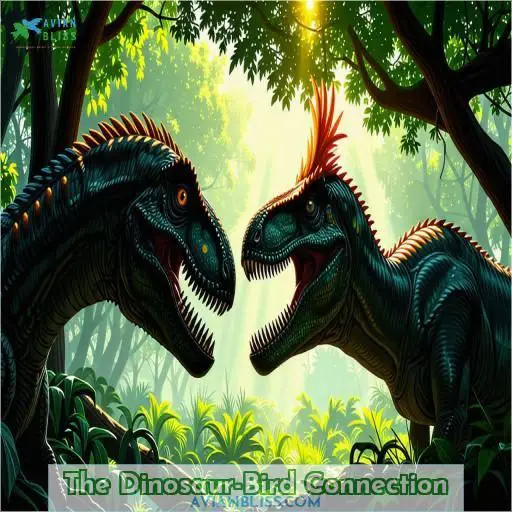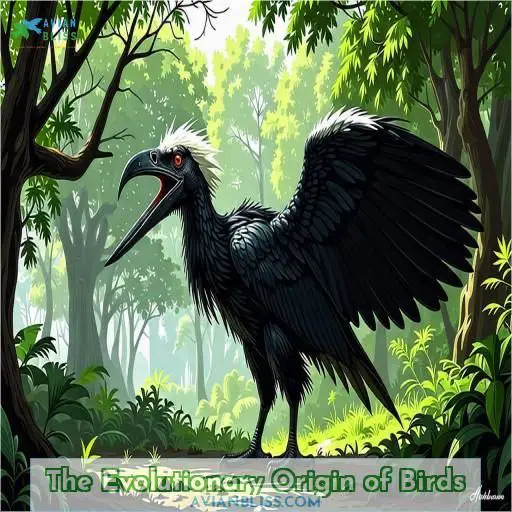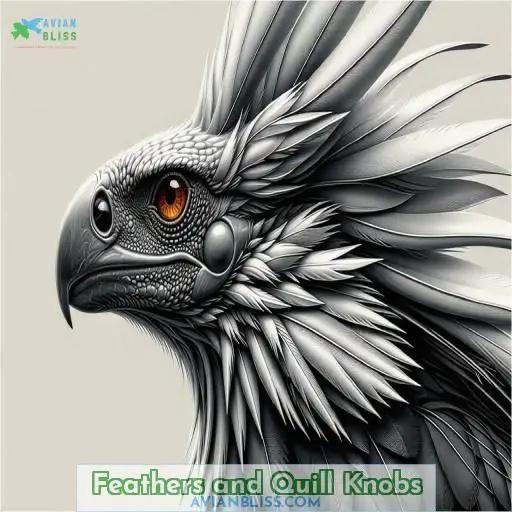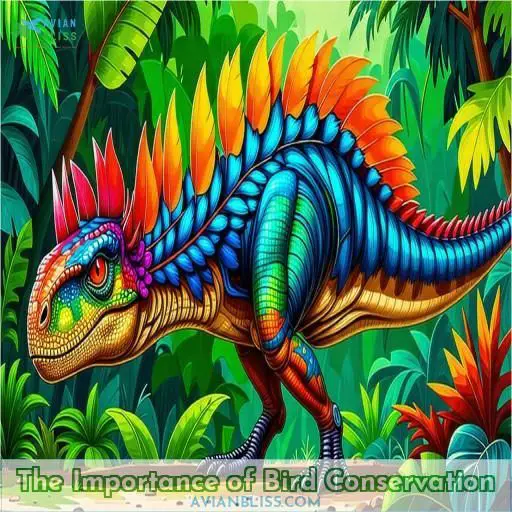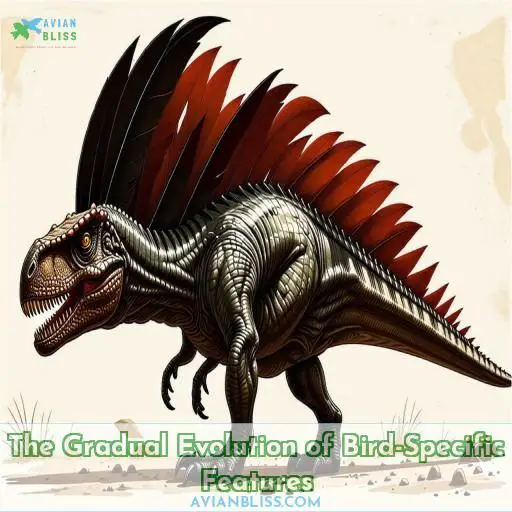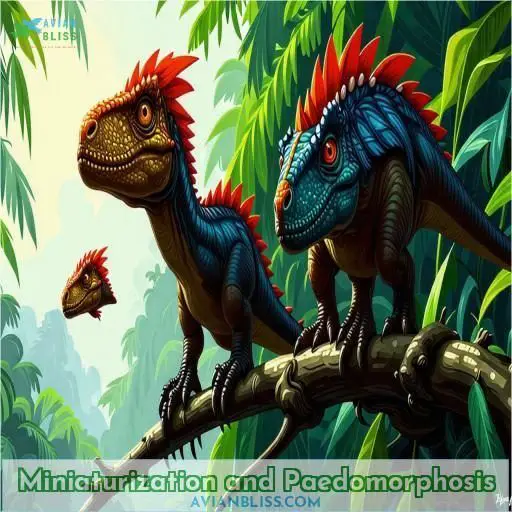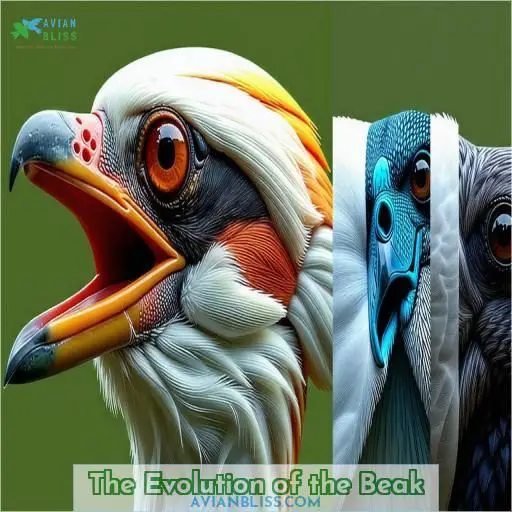This site is supported by our readers. We may earn a commission, at no cost to you, if you purchase through links.
 Yes, birds are dinosaurs. The proof is undeniable.
Yes, birds are dinosaurs. The proof is undeniable.
Birds evolved directly from feathered theropod dinosaurs such as Velociraptor. Present-day birds inherited fundamental dinosaurian characteristics like beaks, warm-bloodedness, and egg-laying.
The remarkable Archaeopteryx fossil exemplifies an intermediate form between dinosaurs and birds. Birds’ exceptional ability to fly originated from tree-climbing, gliding dinosaur ancestors experimenting with diverse flight methods over millions of years.
If you’d like to comprehend this profound evolutionary connection more thoroughly, there’s a captivating tale to unravel.
Table Of Contents
- Key Takeaways
- Are Birds Dinosaurs?
- The Dinosaur-Bird Connection
- The Evolutionary Origin of Birds
- The Evolution of Flight in Birds
- Feathers and Quill Knobs
- Dinosaur Traits in Modern Birds
- The Importance of Bird Conservation
- The Gradual Evolution of Bird-Specific Features
- Miniaturization and Paedomorphosis
- The Evolution of the Beak
- The Survival of Birds After the Cretaceous Extinction
- Frequently Asked Questions (FAQs)
- Are birds a dinosaur?
- Which bird is closest to dinosaurs?
- Why don’t we call birds dinosaurs?
- Are birds the only dinosaurs left?
- How did birds evolve such diverse beaks?
- What adaptations allowed birds to survive the asteroid impact?
- Why are birds the only surviving dinosaurs?
- How do birds metabolic rates compare to other dinosaurs?
- What unique behaviors do birds exhibit that dinosaurs did not?
- Conclusion
Key Takeaways
- Birds evolved directly from feathered theropod dinosaurs and share fundamental dinosaurian characteristics like beaks, warm-bloodedness, and egg-laying.
- Transitional fossils like Archaeopteryx provide tangible evidence of the evolutionary connection between dinosaurs and birds.
- Birds emerged as the most successful flyers among their dinosaur relatives, thanks to key adaptations like feathers and high metabolic rates.
- Birds inherited several key traits from their dinosaur ancestors, including beaks, warm-bloodedness, and egg-laying, while powered flight likely originated from bird-like dinosaurs that were tree-climbing gliders.
Are Birds Dinosaurs?
Yes, birds are considered a type of dinosaur. This is because birds evolved from a group of feathered, bipedal dinosaurs known as theropods, which includes famous dinosaurs like Velociraptor and Tyrannosaurus rex.
The Dinosaur-Bird Connection
You may be surprised to learn that birds are actually living dinosaurs!
Their avian ancestors evolved from a group of meat-eating dinosaurs called theropods.
Theropod morphology, like bipedal locomotion and feathers, provides a clear evolutionary pathway bridging birds to their dinosaurian roots.
Transitional fossils like Archaeopteryx, with its mix of dinosaur and bird features, offer tangible evidence of this connection.
Feathers, once thought unique to birds, have now been discovered on many theropod dinosaurs.
Miniaturization and paedomorphosis (retaining juvenile traits) were key factors in the dinosaur-bird transformation, enabling the evolution of flight.
So next time you see a bird, remember you’re looking at a living dinosaur!
The Evolutionary Origin of Birds
As you explore the evolutionary origins of birds, you’ll find that the theropod dinosaurs, such as the mighty Tyrannosaurus rex, had a bipedal stance and some bird-like features, suggesting their ancestral connection. Archaeopteryx, with its combination of feathered wings and dinosaur-like teeth and tail, stands as the earliest known intermediary form connecting the gap between dinosaurs and modern birds.
Theropods Had Bipedal Locomotion and Some Bird-like Features
Theropod dinosaurs, the ancestors of birds, had a unique bipedal locomotion similar to modern birds.
These meat-eating dinosaurs shared many bird-like features, such as feathers and lightweight, hollow bones.
Theropod similarities to birds provide compelling evidence for the evolutionary origin of avian species from dinosaur ancestors.
Studying theropod bipedalism offers insights into the dinosaur-bird connection and the gradual evolution of bird-like traits in dinosaurs over millions of years.
Archaeopteryx as the Earliest Known Bird-like Dinosaur
Archaeopteryx, a remarkable fossil from the Late Jurassic, is considered the earliest known bird-like dinosaur. This primitive creature had feathers, wings, and a beak, yet also retained dinosaur features like teeth and a long bony tail. Archaeopteryx’s unique blend of avian and reptilian traits provides a key evolutionary link between birds and their theropod dinosaur ancestors.
- Archaeopteryx had feathers, wings, and a beak, yet also retained dinosaur features like teeth and a long bony tail.
- This fossil provides a key evolutionary link between birds and their theropod dinosaur ancestors.
- Archaeopteryx’s blend of avian and reptilian traits suggests a gradual shift from dinosaurs to the first birds.
- The discovery of Archaeopteryx was a significant breakthrough in understanding the dinosaur-bird connection.
The Evolution of Flight in Birds
You’ll be surprised to learn that not all dinosaurian relatives of birds could actually fly. While some had various flight experiments—from gliding to flapping—modern birds emerged as the most successful flyers, having refined and perfected powered flight over millions of years of evolution.
Not All Dinosaurian Relatives of Birds Could Fly
Not all of the dinosaurian relatives of birds could actually fly.
While some developed gliding adaptations, many non-flying dinosaurs still retained their small size and feathered coverings.
This suggests that early avian locomotion involved a variety of experimental flight methods before the evolution of true powered flight in modern birds.
Their small size and ability to fly were key factors in the survival of birds after the dinosaur extinction event.
Various Methods of Flight Experimentation Among Early Bird Ancestors
Early bird ancestors experimented with various flight methods.
Some glided from trees, while others flapped their wings to take to the air.
Adaptations like feathers and hollow bones helped with flight initiation and control.
Diverse flight styles emerged, from soaring to powered flight.
After the asteroid strike and volcanic eruptions, birds’ ability to fly and eat different foods helped them survive.
Birds as the Most Successful Flyers Among Dinosaur Relatives
Birds emerged as the most successful flyers among their dinosaur relatives, thanks to key adaptations like feathers and high metabolic rates. While not all dinosaur ancestors could take to the skies, those that did experimented with various flight methods. Ultimately, birds’ unparalleled aerial prowess and ecological diversity allowed them to thrive where other dinosaurs perished.
Feathers and Quill Knobs
You’re familiar with the dinosaur-bird connection, but have you considered the evidence from feathers and quill knobs? Fossilized impressions reveal that Velociraptor and other closely related dinosaurs sported feathers, just like their modern avian cousins, providing tangible proof of this evolutionary link.
Feathers as an Inherited Feature From Dinosaurs
Feathers, once thought to be unique to birds, are now known to be an inherited feature from their dinosaur ancestors]. Feathers likely evolved for insulation and display before being adapted for flight. The presence of feathers in non-avian dinosaurs like Anchiornis and Microraptor provides strong evidence for the dinosaurian origin of birds.
- Feathers evolved in dinosaurs for insulation and display before flight
- Feathers are made of beta-keratin, the same material as reptile scales
- Feathers have a complex structure with a central shaft and barbs
- Feathers are found in many non-avian dinosaurs, not just birds
Velociraptor and Other Dinosaurs Had a Bird-like Feather Covering
Velociraptor and its close dinosaur relatives sported a feathery covering, providing a clear evolutionary connection to birds. These feathered dinosaurs were intermediary species, bridging the divide between the mighty theropods and the birds we see soaring overhead today. Their bird-like plumage offers compelling evidence of the close relationship between dinosaurs and their avian successors.
Dinosaur Traits in Modern Birds
You can see clear evidence of dinosaur ancestry in modern birds. Their warm-blooded, egg-laying nature and keratinous beaks evolved from dinosaurs, while powered flight likely originated from bird-like dinosaurs that were tree-climbing gliders.
Beaks, Warm-bloodedness, Egg-laying as Inherited Dinosaur Features
Birds inherited several key traits from their dinosaur ancestors, including beaks, warm-bloodedness, and egg-laying. Triceratops had a beak, showing this feature evolved in dinosaurs before birds. Many dinosaur groups lost teeth and evolved beaks. Birds have faster metabolic rates and very high body temperatures, inherited from warm-blooded dinosaurs]. Egg-laying is another shared reproductive strategy.
- Dinosaurs laid eggs, like modern birds
- Many dinosaurs had feathers, an avian trait
- Dinosaurs and birds share skeletal features like hollow, pneumatized bones
Powered Flight Originating in Tree-climbing, Gliding Dinosaur Ancestors
You may be surprised to learn that the ability to fly in birds actually originated in their dinosaur ancestors. These tree-climbing, gliding dinosaurs were experimenting with various methods of flight long before the first true birds took to the skies. Fossils even show that some dinosaurs had a bird-like feather covering, hinting at their aerial capabilities. The path to powered flight was a gradual process of evolutionary experimentation.
| Dinosaur Ancestor | Feather Coverage | Flight Capability |
|---|---|---|
| Velociraptor | Extensive | Gliding |
| Microraptor | Four Wings | Gliding |
| Anchiornis | Extensive | Gliding |
| Archaeopteryx | Primitive Wings | Flapping Flight |
| Modern Birds | Fully Feathered | Powered Flight |
The Importance of Bird Conservation
You must closely monitor bird populations to detect any signs of decline before species go extinct. Protecting island birds from invasive species introduced by humans is of utmost importance, as the Inaccessible Island Rail exemplifies how even the smallest flightless birds provide invaluable insights into evolution.
Monitoring Birds to Detect Species Decline Before Extinction
Observing bird populations is essential to detect species decline before it’s too late. Habitat destruction and biodiversity loss threaten many birds. Conservation efforts aim to protect endangered species and their habitats. By tracking bird populations, we can pinpoint species at risk and take action to prevent further decline. Monitoring is pivotal to safeguarding our feathered friends for generations to come.
Protecting Island Birds From Introduced Species
Protecting island birds from introduced predators and competitors is essential for preventing extinctions. Monitor bird populations closely to detect declines early. Safeguard habitats and remove invasive species to give island birds the best chance of survival. BirdLife’s work on islands demonstrates the power of targeted conservation efforts to rescue birds from the brink of extinction.
Lessons From the Inaccessible Island Rail About Evolution
The Inaccessible Island Rail, a flightless bird, offers insights into evolution on isolated islands. Its small size, unique adaptations, and vulnerability to introduced species highlight the significance of island biogeography in speciation and conservation endeavors to prevent extinction. Safeguarding island birds is paramount, as they encounter elevated risks from human influences.
| Island Biogeography | Speciation | Extinction |
|---|---|---|
| Isolation leads to unique adaptations | Allopatric speciation common | Vulnerable to introduced species |
| Small population sizes | Founder effects | Habitat loss |
| Limited resources | Genetic drift | Climate change |
| Lack of predators | Adaptive radiation | Invasive species |
The Gradual Evolution of Bird-Specific Features
You’ve learned that birds evolved from theropod dinosaurs, and Archaeopteryx represents a key ] form between these two groups. However, the gradual evolution of bird-specific features like feathers, wings, and a beak contradicts the hopeful monster theory, which posits that major evolutionary changes occur through sudden, large-scale genetic mutations.
Theropod Dinosaurs as the Ancestors of Birds
Theropod dinosaurs, the meat-eating ancestors of birds, had a bipedal body structure ideal for flight evolution. Size reduction mechanisms like paedomorphosis drove miniaturization, while beak development variations adapted to diverse niches. Gliding ancestors experimented with flight, but the Cretaceous extinction allowed only the most successful flyers to survive, forever changing the course of avian history.
- Theropod body structure primed for flight evolution
- Size reduction mechanisms drove miniaturization
- Beak development variations adapted to new niches
- Gliding ancestors experimented with flight
Archaeopteryx as a Transitional Form Between Dinosaurs and Birds
Archaeopteryx, a feathered creature from the Late Jurassic, is a prime example of a bridge between dinosaurs and birds. With its blend of dinosaur and bird-like features, Archaeopteryx offers a window into the progressive evolution of flight adaptations that resulted in the extraordinary variety of modern birds, from migratory patterns to complex behaviors.
| Dinosaur Features | Transitional Features | Bird Features |
|---|---|---|
| Teeth | Feathers | Beak |
| Long Bony Tail | Wing-like Forelimbs | Powered Flight |
| Clawed Fingers | Furcula (Wishbone) | Feather Vanes |
Gradual Evolution of Bird-specific Features, Contradicting Hopeful Monster Theory
Contrary to the hopeful monster theory of sudden, large-scale changes, birds evolved from dinosaurs through a series of small, gradual steps]. Regulatory changes, not new genes or pathways, drove the evolution of bird-specific features like the beak. Simple tweaks to gene regulation had a major impact, morphing dinosaur faces into bird-like beaks over time.
Miniaturization and Paedomorphosis
One of the key factors that paved the way for the evolution of birds was the miniaturization of their dinosaur ancestors. This process began around 200 million years ago.
Paedomorphosis, the retention of juvenile features into adulthood, played a significant role in this miniaturization. It allowed bird ancestors to retain smaller body sizes and features that would later prove advantageous for flight.
Bird Ancestors Began Shrinking 200 Million Years Ago
Your dinosaur ancestors began shrinking over 200 million years ago, paving the way for the small stature of modern birds today.
As theropod dinosaurs evolved into early birds, their diminutive size allowed them to take to the skies.
This miniaturization was a key step in the dinosaur heritage of birds, enabling early gliding experiments that eventually led to powered flight.
The small size of birds is no accident – it’s encoded in their genes!
Paedomorphosis (retaining Juvenile Features) as a Factor in Miniaturization
Paedomorphosis, the retention of juvenile features into adulthood, may have played a key vital role in the miniaturization of bird ancestors. By arresting development, small size opened up new habitats and paved the way for flight. Paedomorphosis likely contributed to increased brain size as well, a precursor to the cognitive abilities of modern birds.
- Paedomorphosis allowed bird ancestors to retain small size into adulthood
- Small size enabled access to new habitats and resources
- Paedomorphosis may have increased brain size in miniaturized dinosaurs
- Small size was a key step in the direction of the evolution of flight in birds
The Evolution of the Beak
The evolution of the beak is a remarkable story of how small changes in gene regulation can drive major morphological adaptations. In birds, the premaxillary bones fuse to form the distinctive beak, while in dinosaurs and other vertebrates, these bones remain separate, shaping the snout. Researchers have found that just a few genetic tweaks can transform a bird’s face into a more dinosaur-like appearance.
| Differentiation | Regulation | Adaptation |
|---|---|---|
| The premaxillary bones fuse to form the beak in birds | Changes in gene expression patterns drive this morphological change | The beak is a versatile structure used for feeding, nest-building, and other key functions in birds |
| This is distinct from the separate premaxillary bones in dinosaurs and other vertebrates | Small regulatory changes, not new genes, are responsible for this evolutionary shift | The beak is a key adaptation that has contributed to the remarkable success and diversity of modern birds |
The evolution of the beak highlights how regulatory changes, rather than large-scale genetic shifts, can have a profound impact on macroevolutionary outcomes.
The Survival of Birds After the Cretaceous Extinction
While most dinosaurs perished in the Cretaceous extinction, birds managed to survive and thrive. Their small size, dietary adaptability, ability to fly, and resilience to habitat changes gave them a distinct advantage.
Birds could easily escape the worst effects of the asteroid strike and find food in new environments. Their feathered bodies also provided insulation, allowing them to regulate their body temperature.
Birds’ survival tactics paid off, as they diversified into over 11,000 species that inhabit every continent on Earth. Today, birds play significant roles in ecosystems and provide evidence for evolution. Their remarkable resilience and adaptability are a testament to the evolutionary success of dinosaurs.
Frequently Asked Questions (FAQs)
Are birds a dinosaur?
Yes, birds are dinosaurs. You’re a direct descendant of the mighty theropod dinosaurs that roamed the earth 65 million years ago.
Which bird is closest to dinosaurs?
The closest living bird to dinosaurs is the hoatzin, a tropical pheasant-like bird with claws on its wings when young. It retains many ancestral dinosaur characteristics.
Why don’t we call birds dinosaurs?
You’re right, we don’t call them dinosaurs because their unique bird traits evolved gradually over millions of years from feathered dinosaur ancestors.
Are birds the only dinosaurs left?
Like the survivors of a bygone era, the avian dinosaurs reign supreme. While their relatives perished, birds’ feathered adaptability and aerial prowess guaranteed their continued evolutionary triumph.
How did birds evolve such diverse beaks?
Bird beaks evolved from simple ancestral beaks through minor genetic changes altering facial development and growth. Natural selection sculpted diverse beak shapes perfectly suited for specialized feeding and survival niches.
What adaptations allowed birds to survive the asteroid impact?
Life’s phoenix ability, birds rose from disaster’s ashes. Lighter frames, adept flight skills, and varied appetites empowered their resilience against earth-shaking cataclysms’ onslaught.
Why are birds the only surviving dinosaurs?
Birds’ tiny stature allowed them to find shelter and sustenance amidst catastrophic environmental changes, while larger dinosaurs perished. Their ability to diversify diets and fly granted evolutionary advantages.
How do birds metabolic rates compare to other dinosaurs?
You’ll discover that birds have faster metabolic rates–up to twice as high as those ancient dinos. This super charged metabolism fuels their incredible ability to fly. Pretty wild that these avian speedsters descend from such sluggish ancestors!
What unique behaviors do birds exhibit that dinosaurs did not?
You’ll see birds doing things dinosaurs couldn’t: weaving intricate nests, migrating seasonally, and communicating through complex songs and calls.
Conclusion
Ultimately, the astonishing 66 million bird species alive today are a testament to their dinosaur ancestry’s resilience. Birds are dinosaurs, undeniably descended from feathered theropods like Velociraptor. Their evolutionary journey exemplifies life’s tenacity, adapting through mass extinctions by mastering powered flight from humble tree-climbing beginnings. Understanding this profound dinosaur-bird connection deepens our reverence for nature’s marvels.

